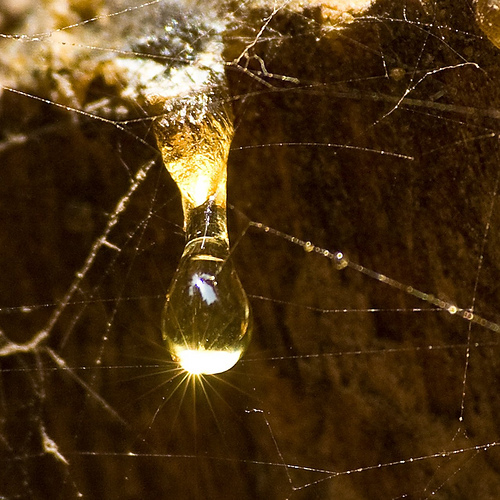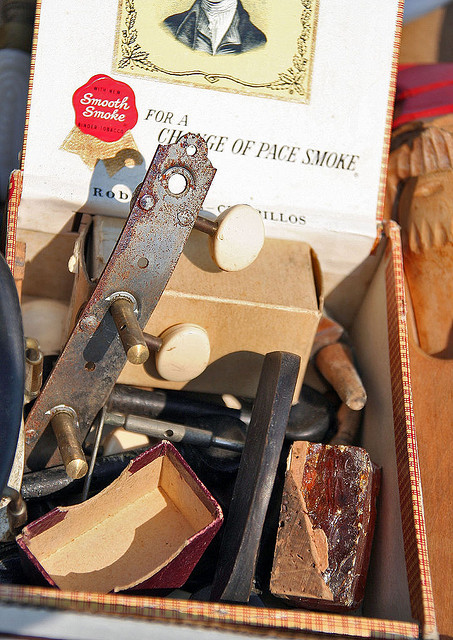As I was writing an article for the About.com Survival Skills website on the topic of how to make a pine pitch torch, I was confronted by many different terms: sap, pitch, resin, tar, among others. Most people seem to use these words interchangeably, but I wanted to know more about what they’re supposed to mean, so here’s what I can gather:
Sap: more of a liquid, like honey or less viscous than honey. Sap is the sugary secretion from plants as well as trees (think raw material for maple syrup).
Pitch: think of an intermediate between a liquid and a complete solid. Pitch is like that crystallized honey you find in your pantry after it’s been there for quite a while.
Resin: usually refers to the most solid of all these forms. If you’ve played an instrument with a bow (like the violin), you’ve probably used a solid block of resin on your bow, as in the photo below right. People seem to use “pitch” and “resin” more interchangeably, while sap usage is reserved more often for the seeping, liquid form.
Now that you’ve got the terminology straight, check out my article on the About.com Survival Skills website:
“How to Make a Pine Pitch Torch”
Photos:
1. © Flickr® user Ian.
2. © Flickr® user Petr Gladkikh.
3. © Flickr® user McBeth.




Not quite. Sap is the plant equivalent of blood in animals- it’s water-based, and it circulates though the body bringing nutrients to tissues and carrying away waste products.
In contrast, pitch is hydrocarbon-based and sits static in special vessels, mainly in the outermost wood layers. Its function is defensive; when a grub chews though the tissues where the pitch vessels are located, the pitch oozes out of the severed vessels and actually pushes the grub clear out the hole where it came in, at least if the tree is healthy enough to produce a lot of pitch. Resin is more like crystallized pitch that’s lost its lighter, more liquid components.
Just because everyone and their uncle uses “sap” and “pitch” as synonyms doesn’t mean that they’re right. It *is* possible for something that ‘everyone knows’ to actually be flat-out wrong.
Thanks for the clarification, Bill, but no need to be a rude snob…!
Sorry you took it that way, Colby.
My point at the end is that nearly all of us (myself certainly included) get led astray now and then by “common knowledge”. Most people have no way of knowing about the difference between pitch and sap unless they happen to stumble upon it by accident, and in the meantime they keep hearing the wrong info on this question from trusted sources around them. That’s life.
I’m no better than anyone else- I just know a few different things than you or the next person, and probably get a few different things wrong that you don’t.
Thank you, Bill. I was looking for a good explanation, and, as you say, everyone saying blue is green doesn’t mean they’re right. You were neither rude, nor a snob. The clarity helps. Even old posts can be goodies.
F aggot
Thx, Colby. Was about to ask specifically on this. Sooo… ifI was after pine PITCH (and not sap)… I would just bruise a pine? Or, do you think resin can be liquified by boiling?
(I’d need it for for sealing earthenware/primitive pottery)
I keep attempting to respond to this, Sapphire, but it doesn’t show that I’ve done so. Maybe it has to be moderated. Here’s the short version: You can liquefy resin by heating it (use a heat-lamp, it’s much easier to control the temperature and keep the material from becoming hot enough to ignite), but it might be too “pure” of volatile chemicals to get it more than gooey. If that’s the case, add a minute quantity of turpentine to it, dissolving enough resin to paint it on your pottery. Obviously, only use turpentine in a well-ventilated area, outside preferred, fan blowing away from you if possible. The turpentine is from pine sap, so you’ll essentially return it to its original state, minus the water.
Thanks for this article, and Bill, I appreciate your addition! As a scientist, I appreciate the addition of ecological function to the discussion–it helps me to remember pitch versus sap, just by thinking of the grub-eject response. Didn’t seem snobby to me, just more stuff to help understand how the pine-trees respond.
I’m hoping to experiment with the tree across the street and I want to be sure I don’t injure the tree or open it up to insect invasion. Any additional information on how to treat the tree after cutting into bark layers would be very welcome! (Yes, I did look at your other article on making pine-pitch–didn’t see any info on protecting the tree. Sorry if I missed it.) Advice?
Wolfonakayak, my understanding is that treatment is not recommended. Long ago gardeners painted pruning wounds with special paint, but that turned out to do more harm than good. You just have to let the tree heal itself. The main problem is if the tree is weakened, like by drought, and can’t defend itself adequately against pests and diseases. Best to not cause any wounds unless you really need to, like when doing corrective pruning.
Thanks, Bill. I have a tree in mind to collect a bit of sap, resin, or pitch from, but I think I’ll just try “attacking” a smaller limb, since I don’t need to extract that much for the purpose of learning how it’s done. It should be easier for the tree to heal if I cut the limb off when I’m finished, leaving a neater, smaller wound to heal.
While it should be really freakin’ cold here in Southern Wisconsin, it’s not (hello, climate-change) and a lot of sap is running early due to the intermittent spurts of 40 to 55 degree weather. I can probably be in and out by the end of March, so the injury is protectively covered with resin before the summer arrives. The El Nino often leaves the Midwest with a hot, dry summer the following year, so I do fear drought.
After reading this and several other articles about pine-pitch, I watched some YouTube videos, and most of them were hideous so far as the care of the tree goes. Maybe that works in Northern Wisconsin’s pine forests, but down here, with the largely deciduous forests, I’m not going to treat any tree as a disposable object.
Then I came across the care of the pine-pitch forests in France, established by Napoleon and well-tended from then until Cyclone Kraus destroyed much of the forest in 2009. That’s a LONG time to develop skills of taking pitch from trees without killing them. I’m going to use their methods, for sure!
the that
Not to pile on with the nitpicking, but resin and pitch are the same thing. The solid form is called rosin.
voodoochili
your answer is more pertinent to the answer I was seeking (by Googling), which was the difference between resin and rosin and what is pine gum (pitch?). ultimately, I was attempting to find out what pine tar is made from and there are so many products with different descriptions using all of the terms above depending on the manufacturer. I’m a country girl, but we just called it pitch. does anyone know which pine element is in pine tar (besides beeswax and some type of oil)? I have seen everything from that it’s derived from processed pine gum to the residue left from burning pine wood.
Pingback: Finding and Using Fire Starting Materials in the Wilderness - Survive!
Pingback: Finding and Using Fire Starting Materials in the Wilderness
Pingback: Discovering and Utilizing Fireplace Beginning Supplies within the Wilderness - Outlast The Fall
Pingback: Finding and Using Fire Starting Materials in the Wilderness - Survival Guides HQ
Pine resin comes from the canbrium layer after it is injured. It is more viscous than sap which is to write deeper within the tree. It is the tree’s response to injury. Rosin, not resin, is what is used for instrument bows. Rosin comes from resin after resin has been distilled so that many of the liquid components, especially turpentine and water, have evaporated off. The residual within the distillation tank after filtering becomes rosin, a translucent yellowish material.
Pine tar derives from the pine timber that has been stacked in a kiln using a smoldering high heat. Pine tar has a blackish yellow slightly translucent appearance. If the pine tar is heated to burn off the volatile components including turpentine and some oils, one obtains pine pitch which is a liquid officially but depending on the process can feel like a crystalline material. Pine pitch is black.
God bless you beautiful soul who wrote that article my deepest love to you .Grateful !